A Thousand Words No. 17
There is so much good photography and videography of windsurfing these days. It's fun to look at and it can be very useful in picking up tips on how the better sailors do things.
We came across the blog for IFJU Fins after following a serendipitous series of links from our own home page. IFJU is a title sponsor for the upcoming IFJU Fins / FORMULA US Eastern Championship to be held in Miami on March 20-22. The latest entry in their blog is an article about Loic Legallois, a French windsurfer who will be competing.
The blog has a pic of Loic sailing a Formula board. The picture is quite instructive of three things that apply not only to Formula boards but windsurfers in general. We could talk and wave our hands on the beach but having the picture here may help a lot more.
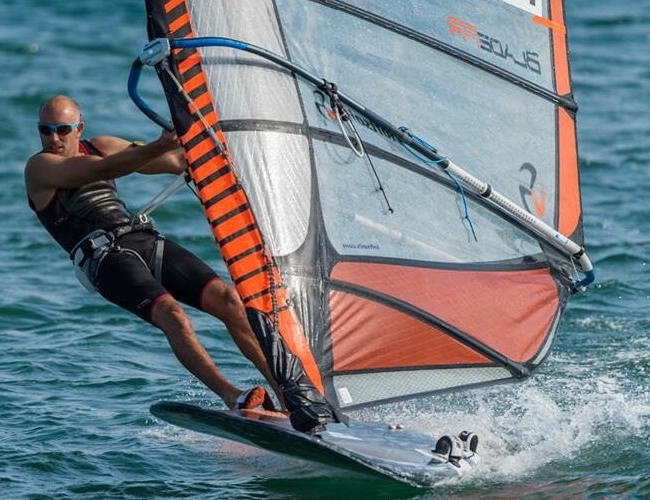
The board and sail might be bigger than anything you have but there's a lot to learn from this picture.
Loic looks powered up on a Formula board and pretty big sail - at least a 10.0 we speculate. The water isn't too rough which suggests just a gentle breeze but he's powered up enough to be riding the fin. Let's take a closer look and see what we can learn.
We've encountered a few times recently where a newbie windsurfer flattens a sail too much with outhaul because some old-skool guy (always a guy) told them to "never let the sail touch the boom". That may have had some practical value in 1985 when booms were narrow; and sails were soft dacron parachutes. Today, it means that poor newbie goes out on a terribly underpowered and twitchy sail that is frustrating to sail even for us (we've tried one of the rigs).
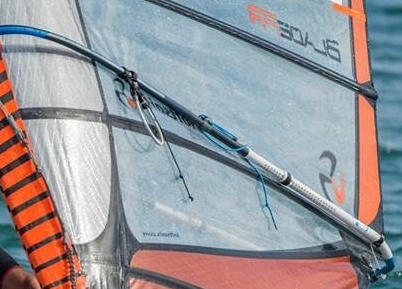
Loic's sail touches the boom from the harness lines all the way back.

This guy is trying to figure out the draft in this sail with yellow lines like ones on a football broadcast.

Football player about to cross imaginary yellow line so he can measure his sail.
We can't be sure that Loic has rigged his sail properly but odds are that he's pretty close as he's a competitive Formula sailor. The proper depth of a sail isn't determined by whether it's touching the boom but how deep the draft is. Bill Hansen, a renowned windsurf sail designer with a background in physics and as a pilot explained it well in an old internet post that we reprinted in our newsletter:
The outhaul (boom length) determines the draft and the resulting performance (power, pointing ability, etc.). In most cases, the proper draft is in the range of 8-12% depending on the sail, conditions of use and desired course (upwind, downwind, etc.) with 10% being a good, all-around setting for normal use (8% is good upwind, 12% is good reaching, downwind.)
You can easily determine and set the draft percentage as follows:
1) Lay the rigged sail flat and have a friend hold the mast base to the ground. Have another friend press lightly down on the mast tip to side-load the mast and simulate a dynamically loaded sailing state.
2) Lay a straight edge across the sail from the mast to the clew at the booms.
3) Measure the chord (boom) length (along the straight edge) and measure the draft (from the straight edge down to the sail membrane at its deepest part.) The draft should be about 10% of the chord length. Example 70" boom => 7" draft.
4) Adjust the boom length in or out to produce the desired draft. A sail’s rigging should ONLY be judged ON THE WATER under the conditions of intended use. You can learn the best settings by making adjustments to the downhaul and outhaul and then sailing to test their effect. The changes in performance and handling due to minor downhaul and outhaul adjustments can be quite dramatic.
Okay, let's be honest. You'll probably never go to this length when rigging a sail. But our point is that he makes no mention of the sail touching or not touching the boom. Rig the sail to get the draft you need for your conditions - and, if that means touching the boom, that's okay. Most sails today are rather accurately marked as to how they should be rigged and many include little gizmos to indicate proper outhaul tension or boom end placement. You are better off following any of these rather than old-skool guy.
Again, we'll blame old school guy because he probably helped you rig your first sail and he still has some piece of crap sail with battens made of dried pasta. In other words, his sail is about as stable as a neurotic girlfriend with daddy issues (or nutjob boyfriend who still lives with his mom - we strive to be gender-neutral). A stable sail means that as it gets powered up and even overpowered, the center of effort - where it pulls - doesn't wander all over the place. Modern sails are wonderfully stable; more wind means you go faster instead of fighting the sail. This allows you to keep your harness lines closer together. When your lines are closer together, your ability to trim and steer the sail improves. It's like going from steering a truck to steering a sports car.
The general advice is having the lines 6-8 inches (15-20 cm ) apart. Some windsurfers like their lines even closer together and DaKine even sells harness lines that are a single line from the boom.
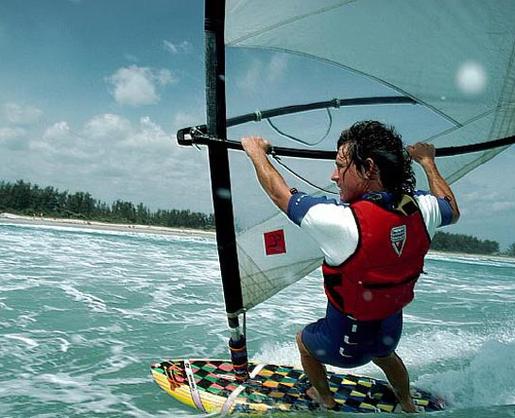
Soft sail meant wide harness lines in the early days.
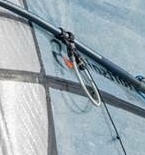
Loic's harness lines are close together even though he has a very big sail.
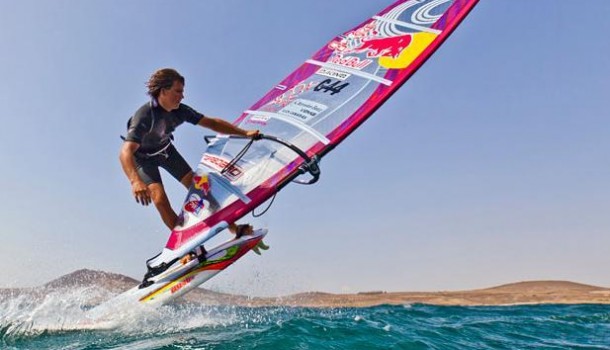

Since you don't believe us, Philip Koster and Antoine Albeau shows us how wide their harness lines are. And for good measure, even depowered in a jump, Albeau shows his sail touching (the horror!) the boom.
Windsurfing equipment is confounding to a beginner. Some things which seem like they should have obvious uses aren't obvious at all. Outhauls and back footstraps are two big offenders in our opinion. And, occasionally, front footstraps.
(Okay, what did we mean by back straps? Back straps on a powered up, choppy day keep body and soul on the board, no doubt. But, on an underpowered day when it's the easiest strap to reach, we see newbies stick a foot back in there when the board is barely planing. All the weight goes back and on the rail which either buries the windward rail or sinks the back- and either makes the board round up and fall off a plane. On those days, we put our back foot just behind the front foot - which is in the strap- and more towards the middle of the board. That keeps the weight off the tail and rail, helps the board to stay on a plane. If you are just starting out, make sure you have nose protection and/or don't put the back foot too close to the front. Otherwise, it's easy to get pulled forward when you are learning and damage the nose of the board.)
The front footstrap to the beginning windsurfer seems to have an obvious purpose: shove your foot in there and push to oppose the power of the sail. A more experienced windsurfer, powered up and heading upwind will do the opposite (please note the words "powered up and heading upwind"). By pulling on the front strap, you help the board pinch into the wind. We've had formula sessions that have left the tops of our feet absolutely sore and this is the reason.
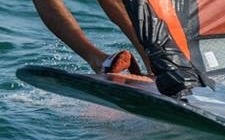
Loic's front foot is pulling up on the strap.
If you are having trouble getting upwind on your board when planing, try it while leaning forward - once best described as "trying to peek around the mast".
We hope these things help. And, if you have any other comments on this picture or other pictures, tell us below.
Webguy, since when are looking to Vin Diesel for windsurfing tips? Sure, if I wanted steal a car or something like that, yeah....
Sure, if I wanted steal a car or something like that, yeah....
What happens in a black hole stays in a black hole.
Eww, boom touching sail is like peas touching mashed potatoes on my dinner plate. WTH is that tiny board (with the wide harness lines)?? I have a single point harness line set-up– like it a lot.
I think the tiny board is partly a result of the camera lens. His shoulders look a lot bigger than his lower body.
Antione says: Eat your peas and mashed potatoes even if they are touching. They'll make you grow up strong (and fast).